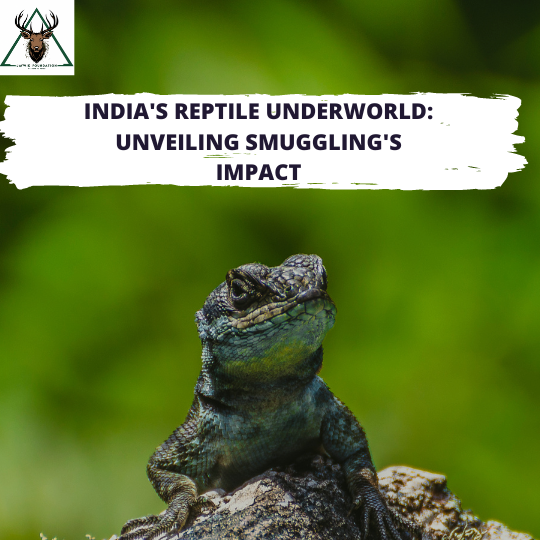In the sneaky world of wildlife crime, people secretly buy and sell exotic reptiles. This is called reptile smuggling. In India, it’s a big deal because there are lots of cool and rare reptiles. But this illegal trade is causing big problems for nature.
Let’s explore this hidden world together. We’ll learn about why people want these reptiles and how they’re taken from their homes. But it’s not just about making money. This trade is hurting our environment and the animals that live there.
Join us as we uncover the truth behind reptile smuggling in India. We’ll see how it’s harming our precious wildlife and what we can do to stop it.
The Allure of the Exotic: Why Reptile Smuggling Thrives in India
People all over the world are drawn to owning rare and wild things. In India, there’s a secret trade in exotic reptiles, like colorful geckos and silent pythons. These animals are seen as treasures because of their beauty and rarity.
People who own these creatures feel special and important. It’s like having a piece of nature’s magic in their hands. But behind this desire is a sad truth: every reptile taken from the wild upsets the balance of nature.
So, while owning these animals might seem glamorous, it comes with a cost. It’s a story of beauty mixed with sadness, as each captured reptile represents a loss for our planet’s biodiversity.
Unveiling the Hidden Networks: How Reptile Smuggling Operates
To understand reptile smuggling in India, imagine peeling back layers of a hidden network, where quiet sounds reveal more than just animals. At the center of this secret trade are people driven by desire and desperation. Poor villagers risk their lives to catch reptiles, selling them to middlemen who work secretly to avoid getting caught.
In big cities, the final deals happen in hidden places, away from public view. Collectors eagerly await their exotic pets, knowing they’re part of something illegal. This smuggling network is smart and always changing to avoid getting caught.
Each sale reminds us of the danger these animals face. Behind the money and cages is a sad story of loss. We all have a duty to protect these creatures, even if they can’t speak for themselves. Exposing reptile smuggling isn’t just about stopping crime; it’s about showing empathy and taking action to save our planet’s wildlife.
From the Western Ghats to Urban Markets: Tracking the Smugglers’ Routes
The journey of a smuggled reptile starts in the lush forests of the Western Ghats, where these creatures have lived for ages. But now, they’re targeted by people who want to sell them for money. The path from these forests to big cities like Delhi and Mumbai is dangerous and secretive.
As the reptiles are taken from their homes, they face risks, and their absence disrupts the balance of nature. Along the way, they’re passed between different people, each making a profit from their capture. This hidden trade not only hurts the reptiles but also harms the environment.
Following the smugglers’ paths isn’t just about tracking where they go. It’s about understanding the damage they cause to our planet. Each step away from the wild takes us further from nature’s harmony, making us think about how our desires impact the world around us.
The Toll on Biodiversity: Understanding the Impact of Reptile Smuggling
Reptile smuggling is a serious threat to biodiversity, the variety of life on Earth. When reptiles are taken from their natural habitats and sold illegally, it disrupts ecosystems and harms the balance of nature. Reptiles play important roles in their ecosystems, such as controlling pests and pollinating plants, so their removal can have far-reaching consequences.
The process of smuggling reptiles involves capturing them from forests and selling them to buyers in cities or other countries. This not only harms the reptiles themselves but also damages their habitats. Smugglers often operate in secrecy, making it difficult for authorities to catch them and stop the trade.
The impact of reptile smuggling extends beyond the reptiles themselves. It affects other plants and animals in the ecosystem, disrupting food chains and leading to imbalances. To combat this threat, efforts are needed to raise awareness about the importance of protecting reptiles and their habitats, as well as to strengthen laws against smuggling and enforce them effectively.
Conservation initiatives play a crucial role in protecting reptiles and preserving biodiversity. By restoring and preserving natural habitats, we can help ensure that reptiles and other wildlife can thrive in their natural environments. Ultimately, by understanding the consequences of reptile smuggling and taking action to address it, we can work towards safeguarding the diversity of life on our planet.
Voices from the Ground: Stories of Resistance and Hope
In the ongoing battle against reptile smuggling in India, there are countless unsung heroes whose bravery and dedication shine through in their efforts to protect our country’s precious wildlife. Take, for example, Ramesh, a forest ranger stationed in the Western Ghats. Every day, he patrols the dense forests, risking his life to intercept smugglers and save endangered reptiles from falling into the wrong hands. Ramesh’s unwavering commitment to conservation has made him a true guardian of India’s biodiversity.
In urban centers like Delhi, individuals like Priya are leading the charge against wildlife crime. As an environmental activist, Priya works tirelessly to raise awareness about the illegal trade in exotic reptiles. Through grassroots campaigns and community outreach initiatives, she empowers citizens to stand up against smuggling and advocates for stronger enforcement of wildlife protection laws. Priya’s passion and determination serve as a beacon of hope for conservation efforts across the country.
Meanwhile, in rural villages, local communities are taking proactive measures to safeguard their natural heritage. From setting up community-led wildlife patrols to promoting sustainable land management practices, these grassroots initiatives are making a real difference in the fight against smuggling. Individuals like Manoj, a farmer from Maharashtra, are leading by example, demonstrating that everyone has a role to play in protecting India’s wildlife.
As a wildlife NGO worker, it is our privilege to work alongside these dedicated individuals, amplifying their voices and supporting their efforts to combat reptile smuggling. By sharing their stories and mobilizing communities, we can inspire collective action and build a brighter future for India’s wildlife. Together, we can ensure that our country’s rich biodiversity continues to thrive for generations to come.
Turning the Tide: How You Can Help Combat Reptile Smuggling
In our ongoing efforts to combat reptile smuggling, we believe that collective action is crucial in safeguarding our planet’s precious biodiversity.
- By raising awareness about the detrimental impacts of wildlife crime, individuals can become powerful advocates for conservation.
- Through education and outreach initiatives, we aim to empower communities to recognize the value of protecting wildlife and to take a stand against smuggling activities.
- Supporting local conservation efforts and advocating for stronger laws and enforcement measures are tangible ways individuals can contribute to the fight against reptile smuggling.
Together, with your support and engagement, we can turn the tide against wildlife crime and ensure a brighter future for our planet’s reptiles and ecosystems.

